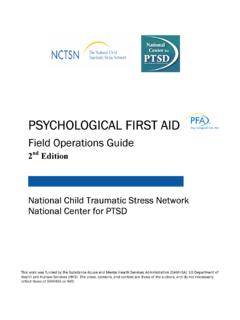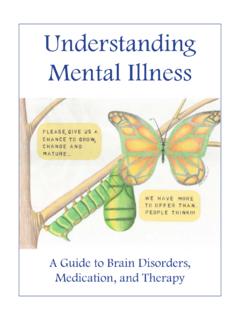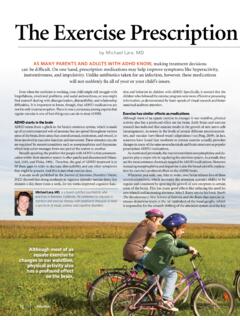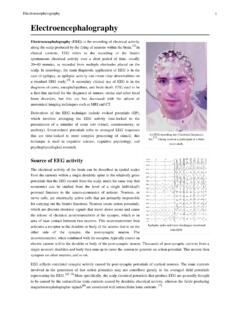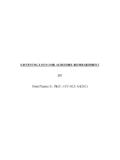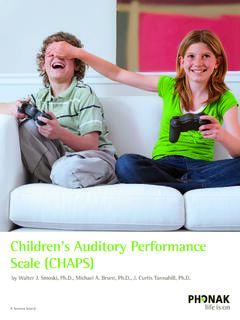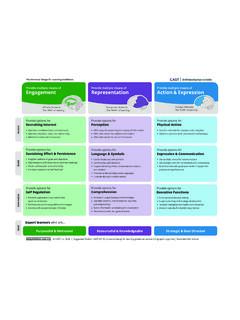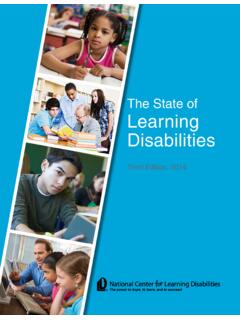Transcription of Individual Intelligence and Adaptive Testing
1 Individual Intelligence and Adaptive TestingMardis Dunham, and Licensed Psychologist Murray State University (KY)December 9, 2020 Purpose of Workshop To review assessment concepts and test interpretation To review distinctions between screening and diagnostic tests To review/discuss IQ, Adaptive , and Achievement Testing concepts and purposes To review/discuss intellectual disabilities via case studiesPhrenology ..Important Assessment Concepts:Criterion Referenced vs Norm Referenced Coverage: Narrow vs Broad spectrum Items: Many items vs Few items Purpose: Instructional vs Diagnostic/eligibility Interpretation: Percentage of Criterion acquired vs Percentile (placement within the norm group) Example Bob has mastered 83% of his times-tables through number 10. Bob s performance on the Woodcock-Johnson Achievement Test placed him at the 53rdpercentile. Percentile tells the % of people, who took the same test as Bob, who scored at or below his score. Anchor point for criterion tests is the test items; for Norm-Referenced Tests it is the population of other people that same age who took that same test Norm-Referenced/Standardized Tests Used for Diagnostic and Eligibility Purposes Can be academic, personality, cognitive/intellectual, and Adaptive All diagnostic, norm-referenced tests have several scales or indices, never just one stand alone score Items for each scale begin very easy and advance to very difficult The number of items a person gets correct is the Raw Score The Raw Score is then compared to the expected or average raw score for that persons age The fewer items correct, the lower the person s reading skills, IQ, memory, etc; the more items correct, the higher the person s skills relative to others their age.
2 When the person s raw score is compared to that of 100s of others their age, the score is converted to a Standard Score this is where the Normal Curve comes in Standardizedmeans that the test is administered the same way to every Distribution Normal Curve an abstract mathematical construct upon which almost all mental measurement (psychometrics) are built. Most well standardized instruments yield scores that are normally distributed that is, the mean, median, and mode are all the same. The Normal Curve allows us to predict/determine the percentage or number of scores falling above, at or below a certain standard score or between two certain points on the and Standard Deviation These are used in concert to establish how far above or below average a person s score on a test falls The Meanis the average (arithmetic mean) The Standard Deviation tells how the scores across a population of test takers is dispersed around the mean. Take the example of archery .. Derived or Standard scores often expressed as deviation IQ scores, these scores have been transformed to have a set mean and set standard deviation.
3 Standard scores allow us to compare how a person performed on two different instruments relative to the population. For example, a standard score on an IQ test of 100 is average, but a standard score on a test of reading of 80 is below average (assuming they both have a standard deviation of 15).Important Scores on Standardized Tests Most all standardized, norm-referenced tests have an average or Mean score of 100 and a standard deviation of 15 pts. Scores 90 to 109 (or 110) are considered average for most tests (This captures the middle 50% of the population) (%iles 25 to 75) Scores 85 to 115 are considered average for other tests (this captures the middle 68% of the population) (%iles 15 to 85) Scores below 70 are at the lowest 2% of the population (this is the magical cut score to consider an intellectual disability. Error of Measurement Every score obtained on a standardized test is composed of the person s true score, =/-error. Error comes from poor administration, over-encouragement, giving feedback, giving suggestions, poor scoring, etc.)
4 This error is normally distributed and predictable called the standard error of measurement or SEm. The SEm forms the confidence band within which the true score will fall 90% of the time (or 68% or whatever). The SEm can be used sparingly to help determine eligibilitySEm Sample The SEm for 95% of standardized IQ, ach, and Adaptive Behavior tests is 3 pts (+/-) So, Julio has a Full Scale IQ of 72. If applying the SEm, his score range is 69 to 75. Because 69 is below 70, we can now consider ID. BUT, take these scores: FSIQ71 Verbal Comp IQ65 Working Memory 63 Perceptual Org IQ80 processing Speed 77 Using SEM would be inappropriate Can use SEM for Adaptive Testing too, BUT CAUTIOUSLYS creening Tests Screening tests are brief assessments designed to find those at risk for certain disorders, who might be eligible for school programs ( , counseling), who might need remediation (via RTI), and who might need comprehensive evaluation (Sattler, 2008) , depression screening, vision screening, behavior screening, substance abuse screening, ADHD screenings.
5 Used in schools, clinics, hospitals, and private practice as part of a two-step process Typically used by paraprofessionals are quick and easy to give and score Minimal training required; easy to purchase Typically, no credential required to use Measure a narrow-band of functioning ( , attention, low mood, word reading, verbal expression) Commonly group or computer administered Typically multiple-choice format (to limit training required and to increase reliability) Designed to prevent unnecessary comprehensive ( , diagnostic and expensive) testingSample Cognitive Screeners Kaufman Brief Intelligence Test-2 (KBIT-2) Scholastic Abilities Test for Adults (SATA) Aptitude Quotient Wechsler Abbreviated Scale of Intelligence -2 (WASI-2) Shipley-2 Test of Nonverbal Intelligence (TONI) Raven s Progressive matrices Naglieri Nonverbal Ability Test (NNAT)Sample Academic Screeners Wide Range Achievement Test Nelson-Denny Curriculum-based assessments Scholastic Abilities Test for Adults short-forms of comprehensive achievement tests Academic screeners often measure low-level/basic academic skills (word reading, spelling, math calculation)
6 Typically no measure of academic comprehension/application or speed/fluency Not co-normed with cognitive tests Interpretation is very limited (not their purpose)Diagnostic Tests These provide detailed evaluation of one s normative and personal strengths and weaknesses in several areas Designed to diagnose conditions and establish eligibility for programs Better norming/better stratification Several subtests normed together permits more comprehensive analysis of scores ( , unexpected differences) Measure low level skills and higher-order reasoning skills and sometimes fluency (for academic skills) Used in schools, clinics, hospitals, and private practice settings Require more training, practice, and credentialing to ethically administer, score, and interpret Typically require undergraduate training (achievement tests) and graduate training and credentials (cognitive and behavior tests) These tests require verification of credentials to purchaseSample Diagnostic Cognitive Tests WAIS-IV (16 89) UNIT-2 (5 to age 21-11) WISC-5 (6 to age 16-11) KABC-2 (3 to age 18-11) Leiter-3 (3 75) WJ-IV Cognitive (2 to age 89) Stanford-Binet-5 (2 85) Wechsler Memory Scale-IV (16 89)Sample Diagnostic Achievement Tests Woodcock-Johnson-IV Tests of Achievement (2 to age 89) Wechsler Individual Ach.
7 Test-3 (6 to age 50) Kaufman Test of Educational Achievement-3 (3 to age 25-11) Gray Oral Reading Test-5 (6 to age 23-11)Sample Diagnostic Adaptive Tests Adaptive Behavior Assessment System Third Edition (ABAS-3) Vineland Adaptive Behavior Scale Third Edition (VABS-3)Getting more into the weeds with IQ Tests ..Wechsler Adult Intelligence Scale Fourth Edition (WAIS-IV) (2008) Average scores are 90 to 109 FACTORS/INDICES Full Scale (composite of 10 subtests) Verbal Comprehension (3 subtests) Perceptual Organization (3 subtests) processing Speed (2 subtests) Working Memory (2 subtests)130 + Very Superior120 129 Superior110 119 is High Average90 -109 is Average80 -89 is Low Average70 79 is Borderline69 and below is Extremely LowDescriptions of ScoresOrganization/Structure: FSIQFull Scale IQVerbal ComprehensionPerceptual ReasoningProcessing SpeedWorking MemoryFSIQ Primarily seen as a measure of general or overall Intelligence Simply a compilation of 10 subtests but is generally seen as the best indicator of a wide range of factors (adaptation, learning, academics, etc.)
8 Scale Descriptors: Primary ScalesVerbal Comprehension Index (VCI) Measures the ability to access (retrieve) and apply acquired word knowledge, verbal conceptual thinking, verbal reasoning, and verbal expression. Vocabulary, Information, and SimilaritiesPerceptual Organization (POI) Measures the ability to grasp underlying conceptual relationships among visual stimuli, ability to use reasoning to identify and apply rules, inductive reasoning, simultaneous processing , and novel problem solving Block Design, Matrix Reasoning, Figure WeightsWorking Memory (WMI) The ability to register, maintain, and manipulate visual and auditory information in immediate/conscious awareness. Requires attention, concentration, good immediate storage, and mental resequencing Digit Span and ArithmeticProcessing Speed (PSI) Measures speed and accuracy of visual registration, decision making and decision implementation. Taps visual scanning, visual memory, visuomotor coordination and concentration Coding and Symbol SearchWoodcock-Johnson IV: Tests of Cognitive Abilities (2014)Schrank, McGrew, & MatherOrganization/Structure: Gf-GcGf-GcComprehension-Knowledge (Gc)Fluid Reasoning (Gf)Gf-Gc Composite (not for ID diagnosis) This estimates IQ based upon the four higher order/g-saturated subtests.
9 4 Subtests Subtests that measure lower-level abilities are removed Average Scores are 90 to 110 Like the WAIS, WJ-COG cores < 70 indicate IDGeneral Intellectual Ability and GIA Extended (may*be used for ID Diagnosis) 10 subtests or 14 subtests (Extended)*not my top test for IDGIA Extended IndicesComprehension-Knowledge (Gc)Breadth and depth of knowledge and skills, including verbal communication and information. Reasoning, when using a previously learned procedure, is included as wellFluid Reasoning (Gf)The ability to reason and solve problems that involve novel information. Includes the reorganization, transformation, and extrapolation of informationShort-Term Working Memory (Gsm)The ability to encode, maintain, and manipulate information in immediate awareness. Includes the capacity to perform these procedures and the efficiency of attentional control to manipulate information in immediate processing (Ga)The ability to discriminate, encode, employ and synthesize auditory stimuli.
10 Long-Term Retrieval (Glr)The ability to encode, consolidate, and retrieve information over periods of time after being displaced from immediate awareness. Involves the amount that can be stored and the rate and fluency that it can be accessed or retrievedVisual processing (Gv)The ability to analyze and synthesize visual stimuli and to employ and manipulate mental images to solve problemsCognitive processing Speed (Gs)The speed and efficiency at performing cognitive tasks, particularly when under pressure to sustain controlled attention and concentrationAcademic Achievement TestsMost popular include .. Woodcock-Johnson IV Tests of Achievement(2 89) Wechsler Individual Achievement Test-IV (6 to 16-11) Kaufman Test of Educational Achievement(3 25) Average scores are 90 to 109, 90 to 110, or 85 to 115 All Comprehensive, standardized/Diagnostic achievement measure: Basic Reading, Reading Comprehension, Reading Speed, Decoding Math Computation, Math reasoning, Math calculation speed Spelling, Written expressionAdaptive Behavior A person s competence in meeting the natural and social demands of one s environment, including self-help skills, social skills, communication skills, coping skills, community navigation skills.

